PEUGEOT 5008 2014 Owners Manual
Manufacturer: PEUGEOT, Model Year: 2014, Model line: 5008, Model: PEUGEOT 5008 2014Pages: 404, PDF Size: 23.34 MB
Page 221 of 404
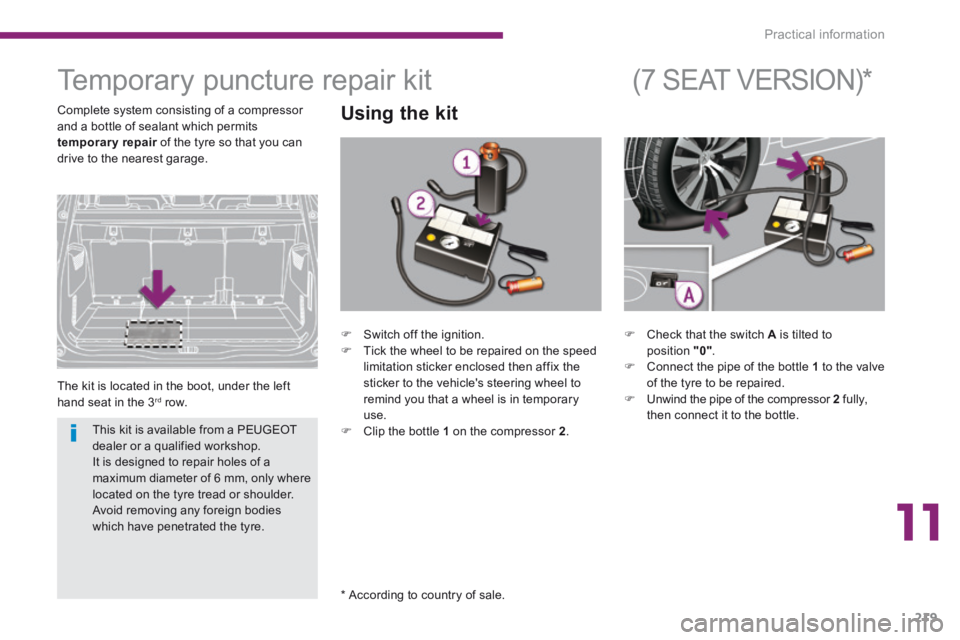
11
Practical information219
Temporary puncture repair kit
The kit is located in the boot, under the left hand seat in the 3 rd row.
Using the kit
* According to country of sale.
(7 SEAT VERSION) *
Complete system consisting of a compressor and a bottle of sealant which permits temporary repair of the tyre so that you can temporary repair of the tyre so that you can temporary repairdrive to the nearest garage.
Check that the switch A is tilted to position "0" . Connect the pipe of the bottle 1 to the valve of the tyre to be repaired. Unwind the pipe of the compressor 2 fully, then connect it to the bottle.
Switch off the ignition. Tick the wheel to be repaired on the speed limitation sticker enclosed then affix the sticker to the vehicle's steering wheel to remind you that a wheel is in temporary use. Clip the bottle 1 on the compressor 2 . This kit is available from a PEUGEOT dealer or a qualified workshop. It is designed to repair holes of a maximum diameter of 6 mm, only where located on the tyre tread or shoulder. Avoid removing any foreign bodies which have penetrated the tyre.
Page 222 of 404

Practical information
220
Switch on the compressor by tilting the switch A to position "1" until the tyre pressure reaches 2.0 bars.
Remove the compressor and store the bottle in the plastic bag, supplied in the kit, to avoid staining your vehicle with traces of fluid. Drive immediately for approximately two miles (three kilometres), at reduced speed (between 10 and 35 mph [20 and 60 km/h]), to plug the puncture. Stop to check the repair and the pressure.
Connect the compressor's electric plug to the vehicle's 12 V socket. Start the vehicle and leave the engine running.
Page 223 of 404
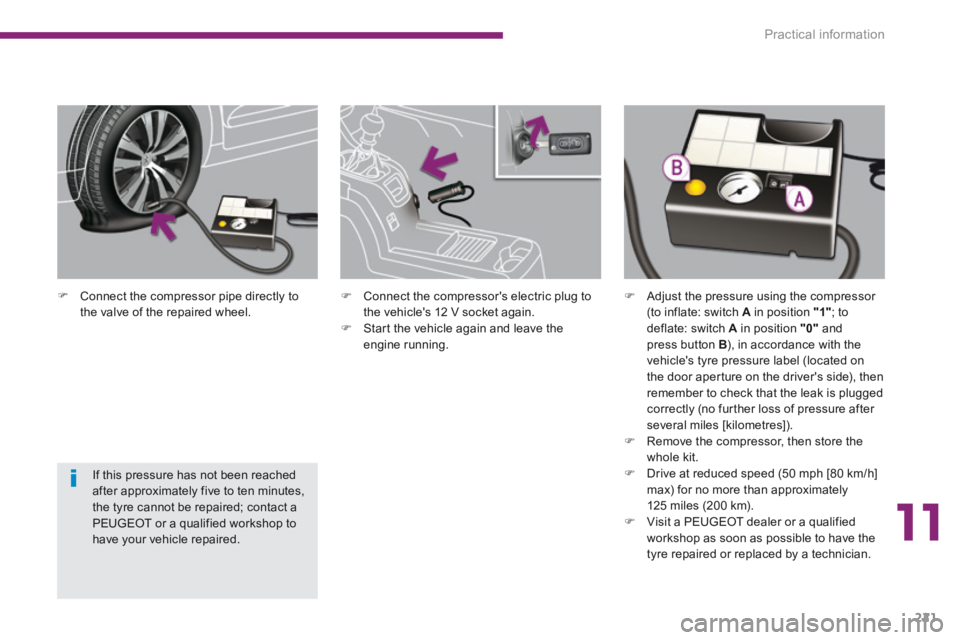
11
Practical information221
Connect the compressor pipe directly to the valve of the repaired wheel.
If this pressure has not been reached after approximately five to ten minutes, the tyre cannot be repaired; contact a PEUGEOT or a qualified workshop to have your vehicle repaired.
Connect the compressor's electric plug to the vehicle's 12 V socket again. Start the vehicle again and leave the engine running.
Adjust the pressure using the compressor (to inflate: switch A in position "1" ; to deflate: switch A in position "0" and press button B ), in accordance with the vehicle's tyre pressure label (located on the door aperture on the driver's side), then remember to check that the leak is plugged correctly (no further loss of pressure after several miles [kilometres]).
Remove the compressor, then store the whole kit. Drive at reduced speed (50 mph [80 km/h] max) for no more than approximately 125 miles (200 km). Visit a PEUGEOT dealer or a qualified workshop as soon as possible to have the tyre repaired or replaced by a technician.
Page 224 of 404
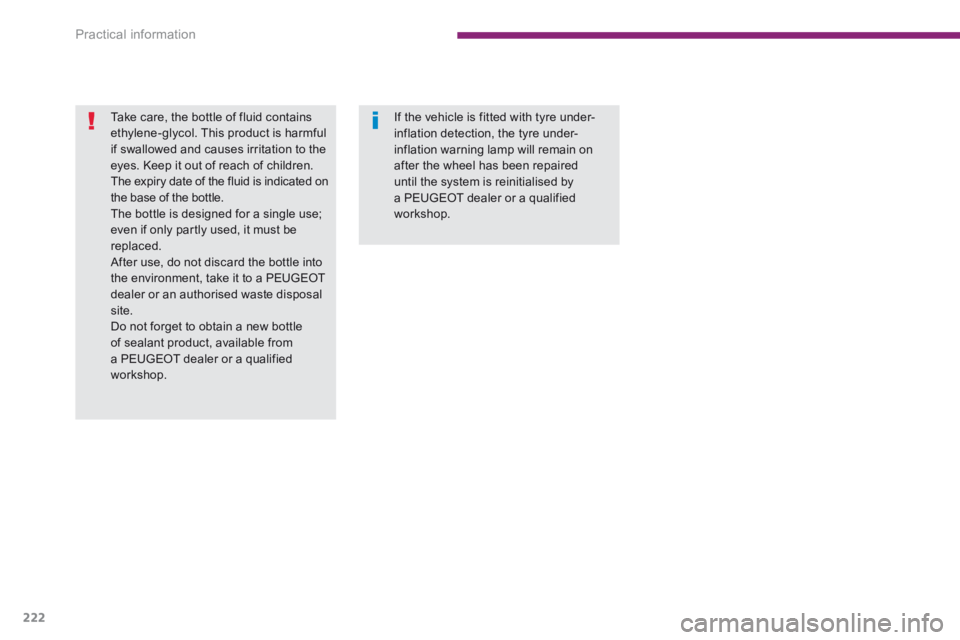
Practical information
222
Take care, the bottle of fluid contains ethylene-glycol. This product is harmful if swallowed and causes irritation to the eyes. Keep it out of reach of children. The expiry date of the fluid is indicated on the base of the bottle. The bottle is designed for a single use; even if only partly used, it must be replaced. After use, do not discard the bottle into the environment, take it to a PEUGEOT dealer or an authorised waste disposal site. Do not forget to obtain a new bottle of sealant product, available from a PEUGEOT dealer or a qualified workshop.
If the vehicle is fitted with tyre under-inflation detection, the tyre under-inflation warning lamp will remain on after the wheel has been repaired until the system is reinitialised by a PEUGEOT dealer or a qualified workshop.
Page 225 of 404
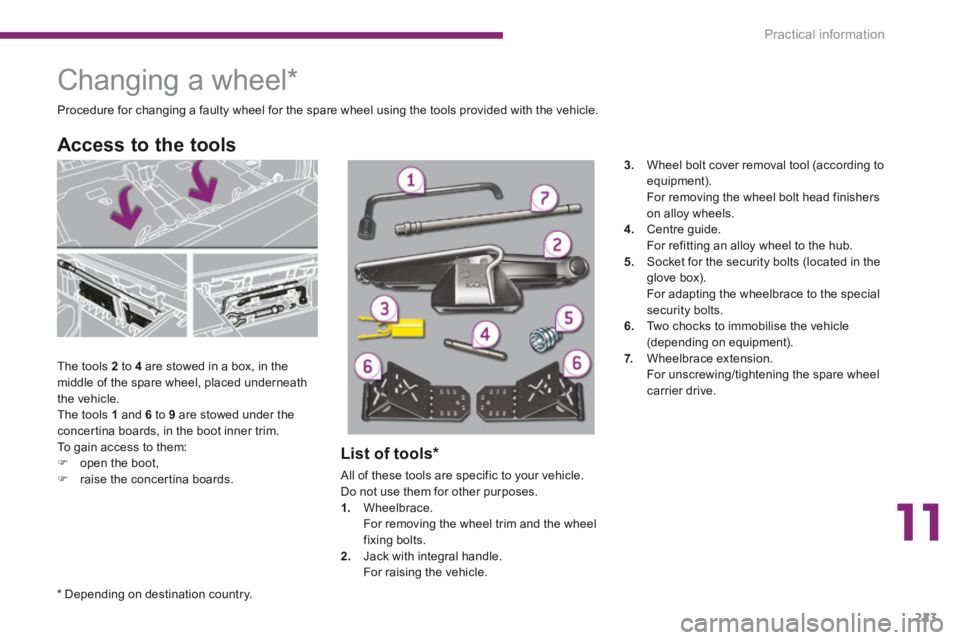
11
Practical information223
Changing a wheel *
The tools 2 to 4 are stowed in a box, in the middle of the spare wheel, placed underneath the vehicle. The tools 1 and 6 to 9 are stowed under the concertina boards, in the boot inner trim. To gain access to them: open the boot, raise the concertina boards.
Access to the tools
Procedure for changing a faulty wheel for the spare wheel using the tools provided with the vehicle.
List of tools *
All of these tools are specific to your vehicle. Do not use them for other purposes. 1. Wheelbrace. For removing the wheel trim and the wheel fixing bolts. 2. Jack with integral handle. For raising the vehicle.
3. Wheel bolt cover removal tool (according to equipment). For removing the wheel bolt head finishers on alloy wheels. 4. Centre guide. For refitting an alloy wheel to the hub. 5. Socket for the security bolts (located in the glove box). For adapting the wheelbrace to the special security bolts. 6. Two chocks to immobilise the vehicle (depending on equipment). 7. Wheelbrace extension. For unscrewing/tightening the spare wheel carrier drive.
* Depending on destination country.
Page 226 of 404
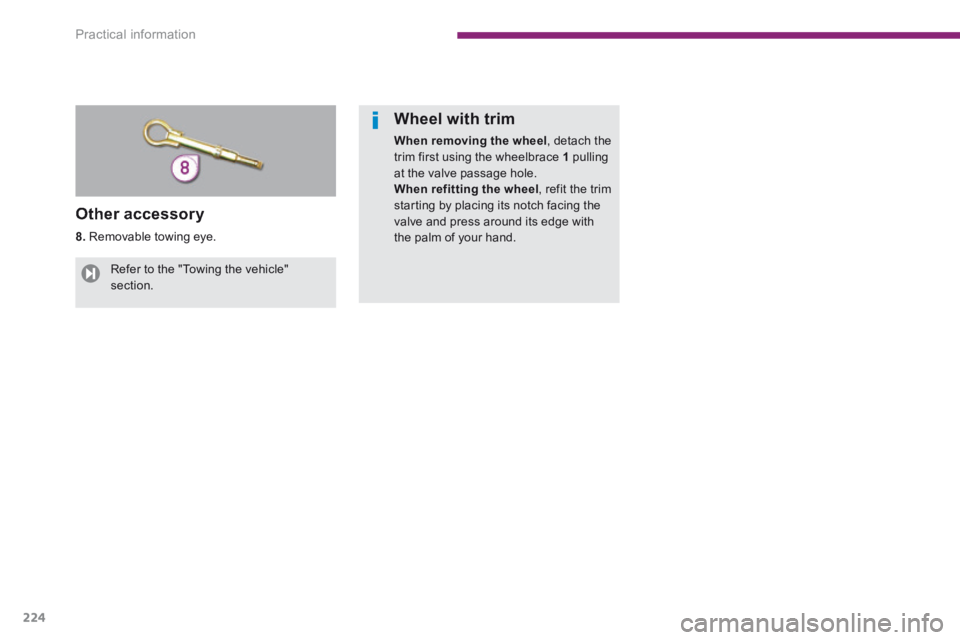
Practical information
224
Other accessory
8. Removable towing eye.
Wheel with trim
When removing the wheel , detach the trim first using the wheelbrace 1 pulling at the valve passage hole. When refitting the wheel , refit the trim starting by placing its notch facing the valve and press around its edge with the palm of your hand.
Refer to the "Towing the vehicle" section.
Page 227 of 404
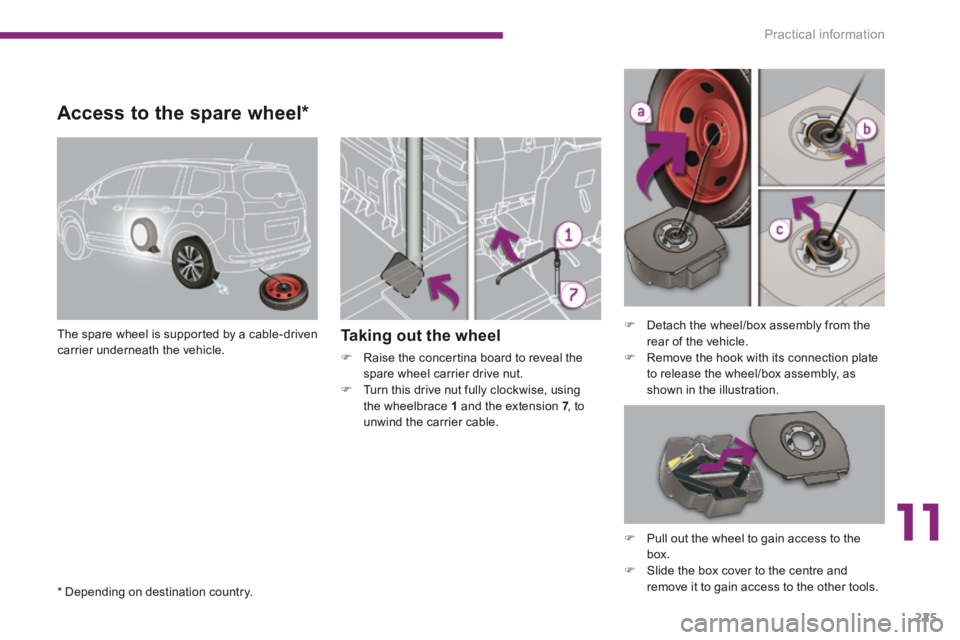
11
Practical information225
Access to the spare wheel *
The spare wheel is supported by a cable-driven carrier underneath the vehicle. Taking out the wheel
Raise the concertina board to reveal the spare wheel carrier drive nut. Turn this drive nut fully clockwise, using the wheelbrace 1 and the extension 7 , to 7 , to 7unwind the carrier cable.
Detach the wheel/box assembly from the rear of the vehicle. Remove the hook with its connection plate to release the wheel/box assembly, as shown in the illustration.
Pull out the wheel to gain access to the box. Slide the box cover to the centre and remove it to gain access to the other tools. * Depending on destination country.
Page 228 of 404
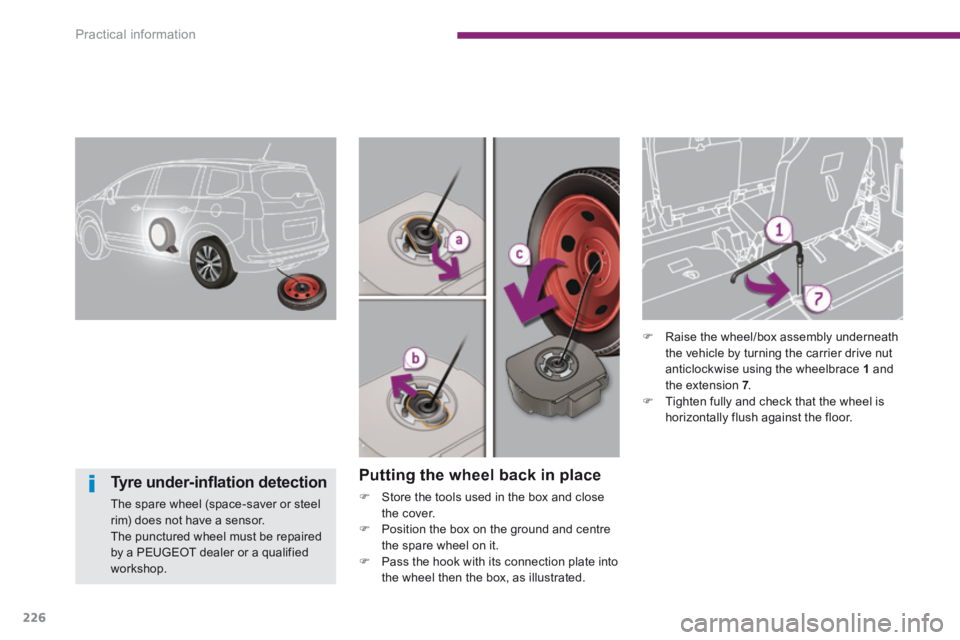
Practical information
226
Putting the wheel back in place
Store the tools used in the box and close the cover. Position the box on the ground and centre the spare wheel on it. Pass the hook with its connection plate into the wheel then the box, as illustrated.
Raise the wheel/box assembly underneath the vehicle by turning the carrier drive nut anticlockwise using the wheelbrace 1 and the extension 7 . 7 . 7 Tighten fully and check that the wheel is horizontally flush against the floor.
Tyre under-infl ation detection
The spare wheel (space-saver or steel rim) does not have a sensor. The punctured wheel must be repaired by a PEUGEOT dealer or a qualified workshop.
Page 229 of 404
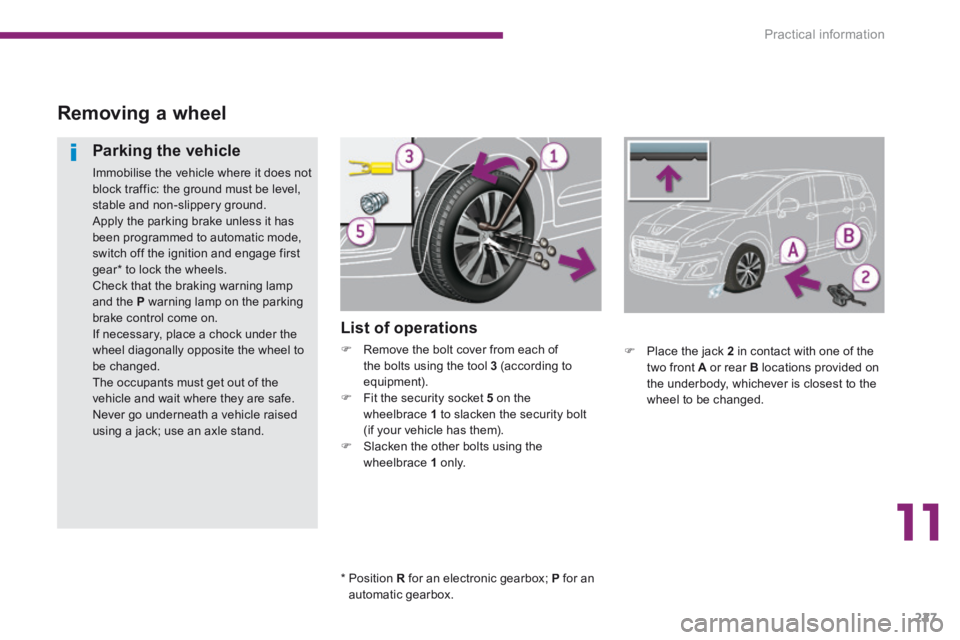
11
Practical information227
Removing a wheel
List of operations
Remove the bolt cover from each of the bolts using the tool 3 (according to equipment). Fit the security socket 5 on the wheelbrace 1 to slacken the security bolt (if your vehicle has them). Slacken the other bolts using the wheelbrace 1 o n l y.
Parking the vehicle
Immobilise the vehicle where it does not block traffic: the ground must be level, stable and non-slippery ground. Apply the parking brake unless it has been programmed to automatic mode, switch off the ignition and engage first gear * to lock the wheels. Check that the braking warning lamp and the P warning lamp on the parking brake control come on. If necessary, place a chock under the wheel diagonally opposite the wheel to be changed. The occupants must get out of the vehicle and wait where they are safe. Never go underneath a vehicle raised using a jack; use an axle stand.
Place the jack 2 in contact with one of the two front A or rear B locations provided on the underbody, whichever is closest to the wheel to be changed.
* Position R for an electronic gearbox; P for an automatic gearbox.
Page 230 of 404
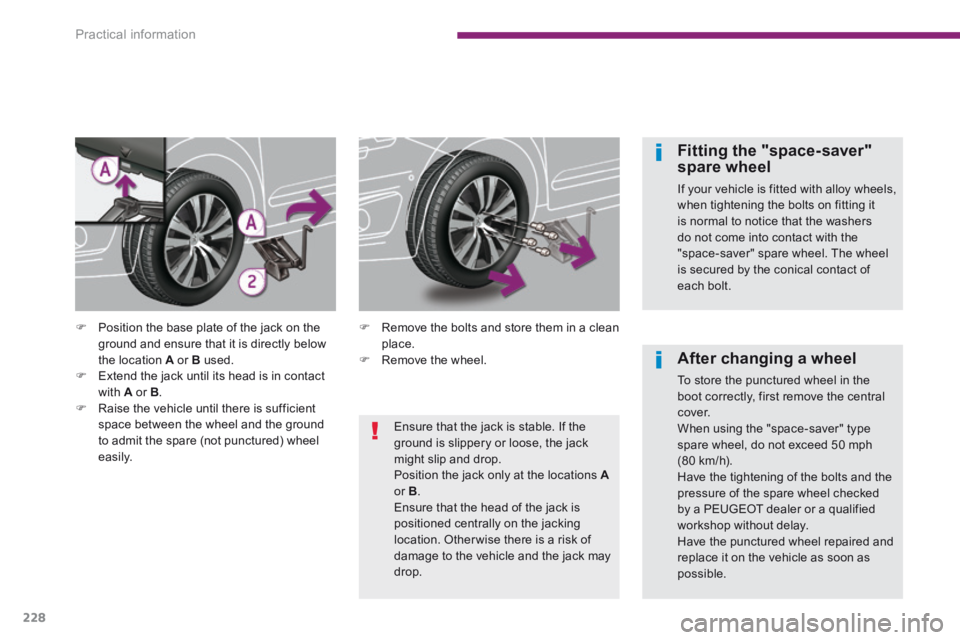
Practical information
228
Fitting the "space-saver" spare wheel
If your vehicle is fitted with alloy wheels, when tightening the bolts on fitting it is normal to notice that the washers do not come into contact with the "space-saver" spare wheel. The wheel is secured by the conical contact of each bolt.
After changing a wheel
To store the punctured wheel in the boot correctly, first remove the central cover. When using the "space-saver" type spare wheel, do not exceed 50 mph (80 km/h). Have the tightening of the bolts and the pressure of the spare wheel checked by a PEUGEOT dealer or a qualified workshop without delay. Have the punctured wheel repaired and replace it on the vehicle as soon as possible.
Position the base plate of the jack on the ground and ensure that it is directly below the location A or B used. Extend the jack until its head is in contact with A or B . Raise the vehicle until there is sufficient space between the wheel and the ground
to admit the spare (not punctured) wheel easily.
Remove the bolts and store them in a clean place. Remove the wheel.
Ensure that the jack is stable. If the ground is slippery or loose, the jack might slip and drop. Position the jack only at the locations Aor B . Ensure that the head of the jack is positioned centrally on the jacking location. Otherwise there is a risk of damage to the vehicle and the jack may drop.